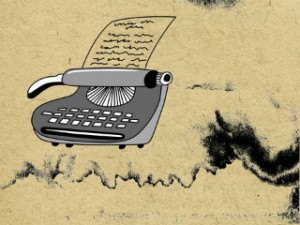Thought I’d add a new feature — the Round Up. I’ll include links to previous posts on an individual topic so you can have everything at your fingertips.
Here are my Editing posts to date:
Nobody likes editing. We’d all rather be writing 24/7 but editing must be done in order to produce a finished work. Here are some quick tips to get you started.
- First Pass: Spelling
Make one run through your work and check just for spelling. You can use a spell-check program or do a quick read-through. A read-through will also catch words that are spelled correctly but used incorrectly, such as your for you’re or two for to.
2. Second Pass: Grammar
This one’s a bit tricker, since you do have to read through the work to catch incorrect grammar. If grammar is your weak spot, this would be a good time to pass the work along to a professional editor. Check for verb tense, dangling participles and other common problems.
3. Third Pass: Word Repetition
Make a pass for one common problem we all have: our favorite phrase. If you don’t know what that is, you might try plugging your text into a tag cloud generator. That’ll show you any words or phrases that show up the most often. If anything jumps out at you, do a search/replace and root out all those repetitions. You might also check for pronoun repetition – paragraphs with too many “he’s” or “she’s” and not enough names (I tend to have that problem).
4. Fourth Pass: Dialogue
Read through your work, focusing on your dialogue. Does each character speak in a unique voice? Can you tell which character is which without looking at name tags? Are your educated characters using longer words and longer sentences than your less educated characters? Make sure your dialogue is believable and logical.
Once you get past that fourth draft, your work is going to be pretty much ready for a professional editor to look at. (Bet you thought I was going to say “ready for publishing” didn’t you?) Never send your work out without having a professional look over it!
Book 3 is finished at last, and I’m doing the first of several edits and polishing jobs. Here are a few tips on polishing your work until it sparkles.
- Read for Flow and Rhythm – do your first pass for the overall story. Does it flow and lead logically from one scene into another? Is it an overall good story or does it lag in spots? Does the tension escalate to a climax?
- Read for Nit-Picks – do another pass looking for those typos and grammatical errors. It helps for this stage if you print the manuscript out and actually “read” it backwards: start at the end and look at every word until you reach the beginning. You’re more likely to spot a misspelling or incorrect word choice that way.
- Read for Dialogue – does your dialogue flow properly, advancing the plot, or does it halt the action and take the readers off on a tangent? Do your characters speak with their own individual voices?
In between your readings, feel free to rewrite as necessary until you have the book you’ve been dreaming of.
Book Two is finished … well, the first draft is done
This is only the beginning, though.
- I’ve got the first edit to do – go through reading for continuity and flow.
- Rewrite as needed from that edit
- Then I’ll do a dialogue edit to make sure all the dialogue sounds good and matches the characters
- More rewriting as needed
- Then there’s the (possibly first) professional edit to see what I need to fix
- Then there may be yet another rewrite … maybe even several
Then, and only then, will I send it to my agent to see what she thinks. It’s not a short process.
How many edits do you go through before you publish?
I’ve been skimming through some books lately, just browsing the genre. Most of what I’m looking at is obviously self-published because there are glaring errors that a professional editor would have caught and corrected. This is something that you can work on so that your books don’t come across as unprofessional.
I found this helpful site from the Oxford dictionary, listing commonly confused words.
Another area where writers err is in commonly-heard sayings. One writer had me gritting my teeth every time she had her characters tell someone they “had another thing coming.” The correct phrase, of course, is “another think coming,” as in “If you think that, you’ve got another think coming.”
Here are some more commonly mis-heard phrases:
- “I could care less” – this means that you do care, and have more caring you could do. If you want to show your total lack of caring, it’s “I couldn’t care less.”
- “Nip it in the butt” – this would mean something’s backside is getting bitten. If you want to cut something out before it starts, you’d be “nipping it in the bud,” just the way you’d nip or pinch off a plant’s bud before the branch or flower forms.
- “For all intensive purposes” – this means your purposes are intense, which probably isn’t what you mean. “For all intents and purposes,” on the other hand, means in every practical sense.
- “One in the same” – this would mean that something was inside another thing that was the same. If you want to say two things are no different, you say “one and the same.”
- “Giving you leadway” – there’s no such word, though it sounds like the correct term. Leeway means room on the lee – or sheltered – side of something; in other words, enough room to pass or do what you need to do.
Editors for Hire (Chantelle Aimee Osman)
Once you’ve written “the end,” the journey is only half over. You must put out the best book you can – if it’s not, you might sell it, but they won’t come back for more.
A clean, polished manuscript can make all the difference – a copy editor is a must if you’re self-publishing and even if you’re going the traditional route, I recommend having your first 5-6 chapters gone over by a professional.
How much editing do you need? Most professional authors might get by with only one edit. Some people need 4-5 edits.
Do a read-only edit yourself before sending it to the editor – catch major errors and over-arching story problems before you send it off for a line edit or line and content edit.
The thing everyone is looking for is your passion on the page. Never write just for a trend. Write what you love to read, what you love to write.
Know your genre – don’t write a zombie vampire YA mystery with Western overtones.
The first two and last two chapters of your book are the most important – have a hook at beginning to make them need to turn the page – no backstory.
Style issues:
- awkward phrasing, repeated phrasing
- do not try to have a unique voice – just write your way and the voice will show through
- the tighter, the better – cut unnecessary words
- preaching is a no-no
- watch for changes in tense or POV
“good dialogue is one of the most difficult and challenges a writer has”
Dialogue problems:
- fake dialogue – not using contractions, very formal, awkward
- dialogue to obviously advanced the plot “radio drama dialogue”
- forced dialogue – do your research
- too many trendy words date your work
- show, don’t tell
- make sure characters have distinct speech patterns
- Read your dialogue (and everything else) aloud
Descriptive problems:
- using the protagonist’s senses to relate information is a better way to show instead of description
- avoid general descriptions (beautiful, nice, etc)
- avoid laundry lists
- watch out for repetition – favorite phrases and images, sentence structure – “crutch words”
- combinations of words with the same meaning
- a set of fresh eyes are valuable in catching these things
- adjectives and adverbs – don’t use too many, never more than one together
- cut 10-15% of your words
- watch “to be” – try to avoid if possible (passive sentences)
- no qualifiers like very or really
- cliches (that also includes cliched descriptions and situations)
- wrong word choices (towards instead of toward, affect/effect, etc)
- watch for sentences with more than two commas – maybe two sentences instead
- now it’s one space after a period
- double check for possessives and plurals
“Punctuation is like a throw-pillow.” Doing the job without calling attention to itself
Errors in character:
- characters must be unique, bring the readers back
- know your characters well, give them clear motivation
- must have goal and clear reason to work toward that goal
- characters must grow
- no stereotypes
- outlandish names – names often paint a better picture than descriptives – you don’t want something that reader must stop reading to figure out how to pronounce it
- misplaced or overly long backstory
Plots:
- if characters just go along without anything interesting happening, there’s no emotional attachment
- every book should have basic essential question (who/what/where/how/why) – know what that question is and be able to resolve it in the end
- don’t write about something you don’t know about
- know your genre!
The End:
- almost as important as the beginning – what’s going to sell the second book
- resolution must make reader feel something
- don’t keep readers wondering in a bad way (forgetting a plot point)
Now you’ve just started on your journey of queries, rejections, edits, cover designs, etc.
Social Media 101 for Creative People (Alison Sky Richards):
3 Points:
- Website (your store front)
- FaceBook (your billboards)
- Twitter (your conversation)
There are around 328 highly utilized social media sites – around 600 total
FaceBook:
- Create an author (or book) page
- Create an author voice
Twitter:
- Be careful who you follow/allow to follow you – spambots and trolls
- Build dialogue and communication – look for your favorite authors and create communication
- Hashtags #amwriting, #amediting – scroll past photos to get to # feed at bottom of screen
Grab your author name on major social media sites – and URL
Websites:
- Responsive design – allow for different devices
- Visual design – images get 10% more response than text
- Appearance – NO Comic Sans! Need an easy to read font like Verdana or Arial – nothing too trendy or crazy. Use tinted background instead of plain white – easier for most people to read. Red is also very visually attractive, but not fire-engine red
- Have your social media integrated
- Search Engine Optimization – takes a lot of work! Need to get a lot of people to look for a specific phrase and click on the website.
- Constantly re-evaluate your website. Check content for freshness and readability – average reading level is 8th grade – recommended website level 6th. Rebrand website to be most effective.
Revision can be tough. Sometimes it’s hard to take a good, clear look at what you’ve written.
Here are some good tips to get you started on the revision process:
- Start at the beginning – Editing is easier when you follow your story the same way your readers will. Starting on page one will not only help you to catch typos, but allow you to check for plot holes, continuity and characterization.
- Highlight all passive verbs. Look for is, are, was, were and has/have been. If the sentence can be rewritten into active voice, do so. If not, consider eliminating the sentence entirely. You do need passive voice occasionally, but keep it to the bare minimum.
- Get rid of the cliches. HERE’S a great list by Writer’s Digest of the most commonly used cliches. Do a find-and-replace search to be sure none of these have crept into your story.
Once you get into Edit Mode, you’ll find that it flows right along.
Susan Cummins Miller gave a great talk at the Tony Hillerman Conference. Here are the highlights:
A Baker’s Dozen: Common Writing Mistakes
- Starting at the wrong point – usually it’s too early. Start just before the really interesting part, or the inciting incident
- Lack of dramatization – beginning writers tend to “tell” instead of “show.” Get rid of “telling” adverbs and adjectives and “show” the action and reaction, and give the dialogue.
- Poor plotting – beginning writers often mistake a great premise (the 2-3 line pitch) for a great plot (what actually happens between Chapter 1 and The End. You should know what your characters want, and make them work for it, with a primary objective plus some smaller sub-goals. Each scene must have conflict, a climax, and resolution, and each incident must have repercussions and reactions.
- A contrived ending – let your characters interact and lead you to a logical ending. That needs to grown naturally from the building blocks of your scenes.
- Point of view errors – remember that, whichever point of view you choose, it must emotionally pull the reader into the story. Avoid the authorial voice (“telling”). Also, be sure that the reader knows whose head they’re in. Don’t switch point of view within a scene because that’s too confusing.
- Ineffective dialogue – dialogue should support and develop the plot, or give a little bit of backstory. Check for stilted or uninspired dialogue, or for cliches. Enliven your dialogue with revealing details.
- Weak characterization – no cardboard characters allowed. Your characters must be three-dimensional and emotional beings.You have your entire novel to reveal backstory, so avoid the temptation to tell everything about the character all at once. Give small, specific details a little at a time instead. Know what makes your character travel (physically or emotionally) toward their goals and remember to place them in stressful situations.
- A pointless story – this is when your reader finishes the book without having an “aha!” moment. It usually means you’ve either failed to define your objective, or neglected to show the development of your protagonist. The solution is to make sure that every action has a reaction and leads inevitably toward the climax and resolution.
- Flat writing – this is caused by “playing it safe” and not digging too deeply into your own emotions, or by fearing the logical reactions in your story. Cut narrative or dialogue that has no relevance to the plot, and be sure that you’re showing instead of telling.
- Lack of vivid, realistic settings – instead of giving paragraph after paragraph about your setting, choose one or two small but vivid details that will stick with your readers.
- Too much backstory and exposition (the dreaded “info dump”) – choose what’s important and present it in “dribbles and drabbles” in a vivid way. Keep in mind that backstory, if used correctly, can actually increase tension by slowing down the pace and delaying the crisis.
- Failing to listen (to what people say about your work) – Susan recommends that you have a first reader who knows what they’re doing, or that you join a good critique group that will actually provide useful criticism.
- Submitting your work too early – don’t send out your first draft. Be sure you’ve edited and polished until you’re sending out the very best you can produce.
More from the Hillerman Conference to come!









